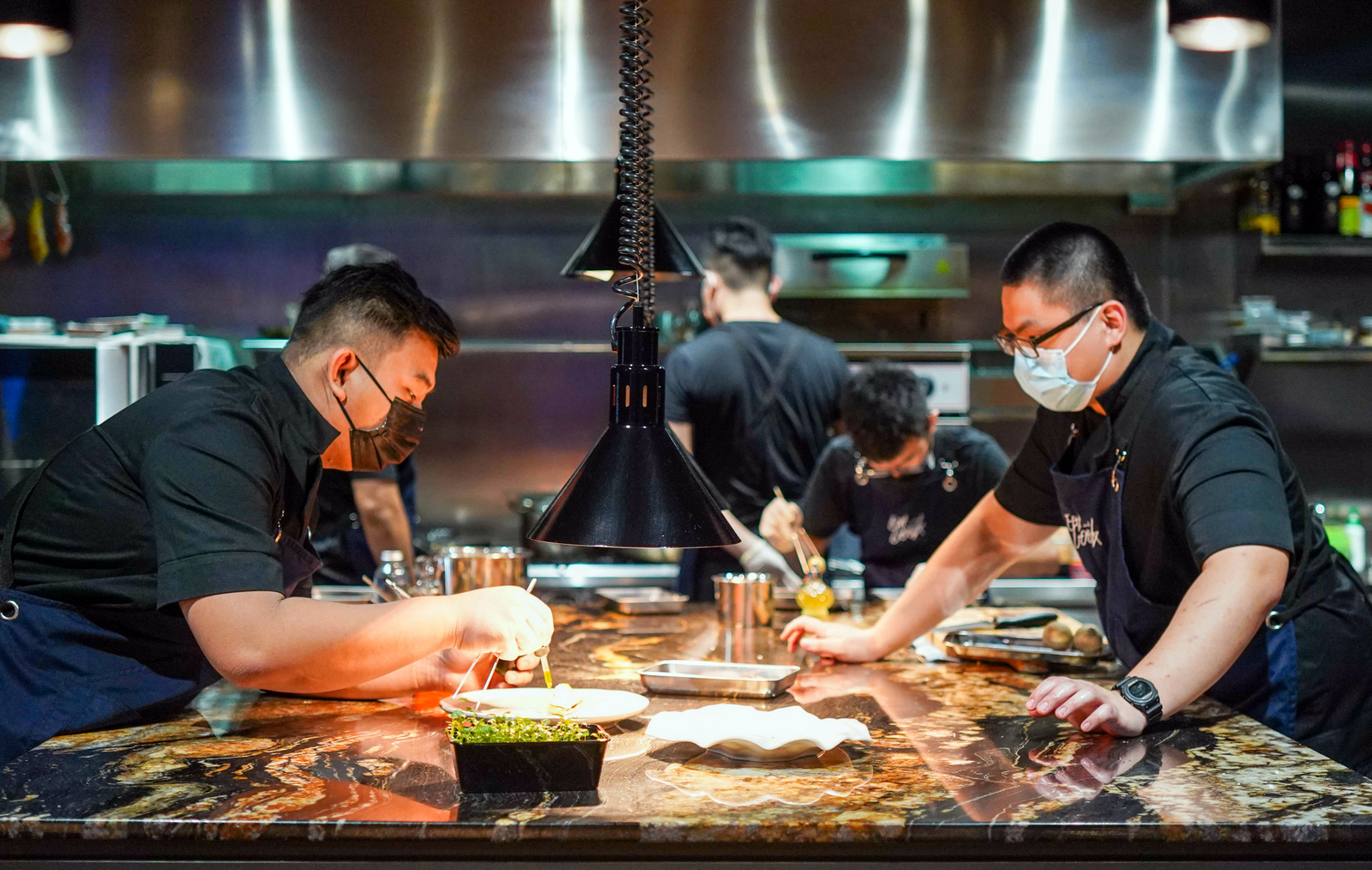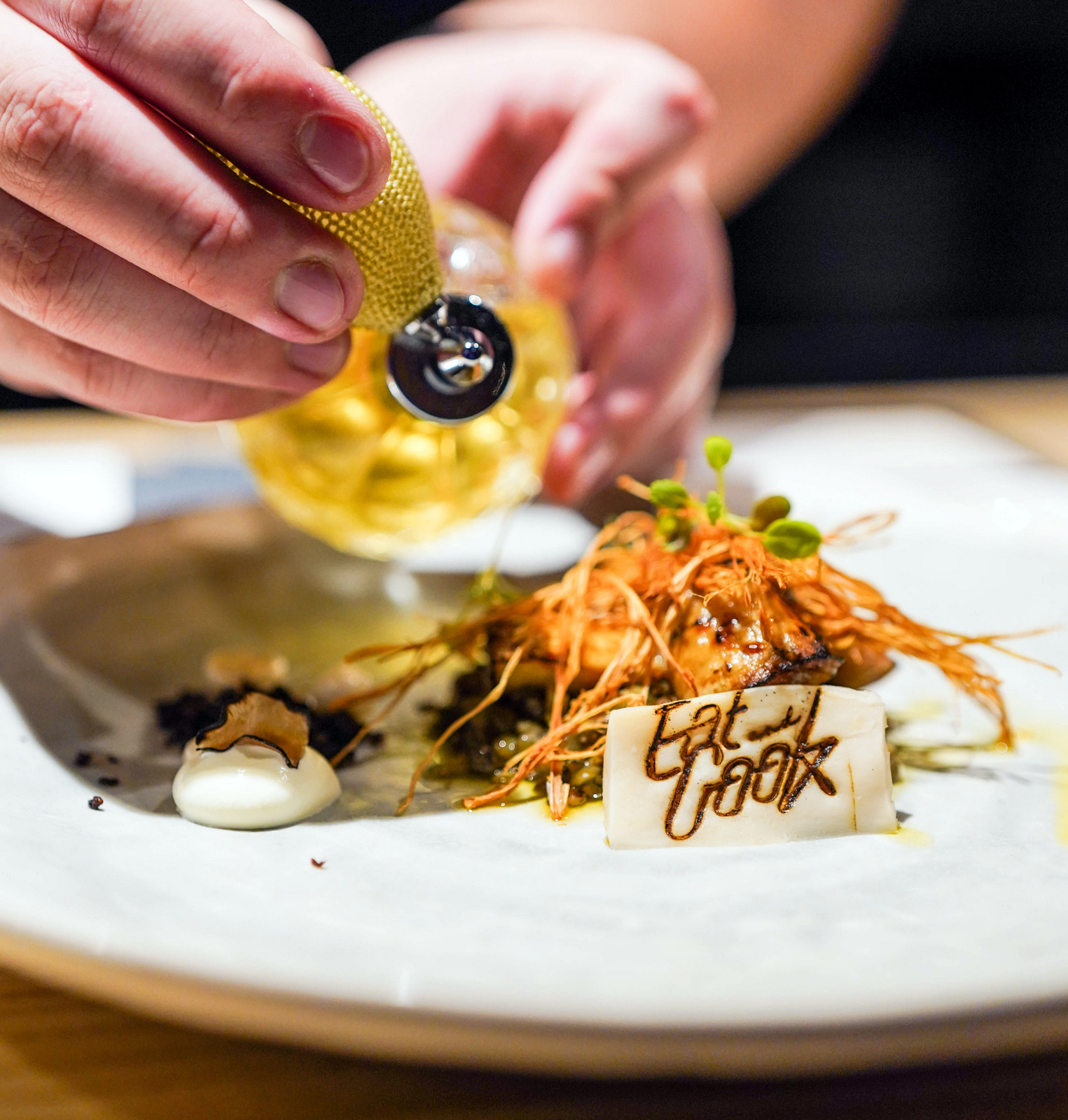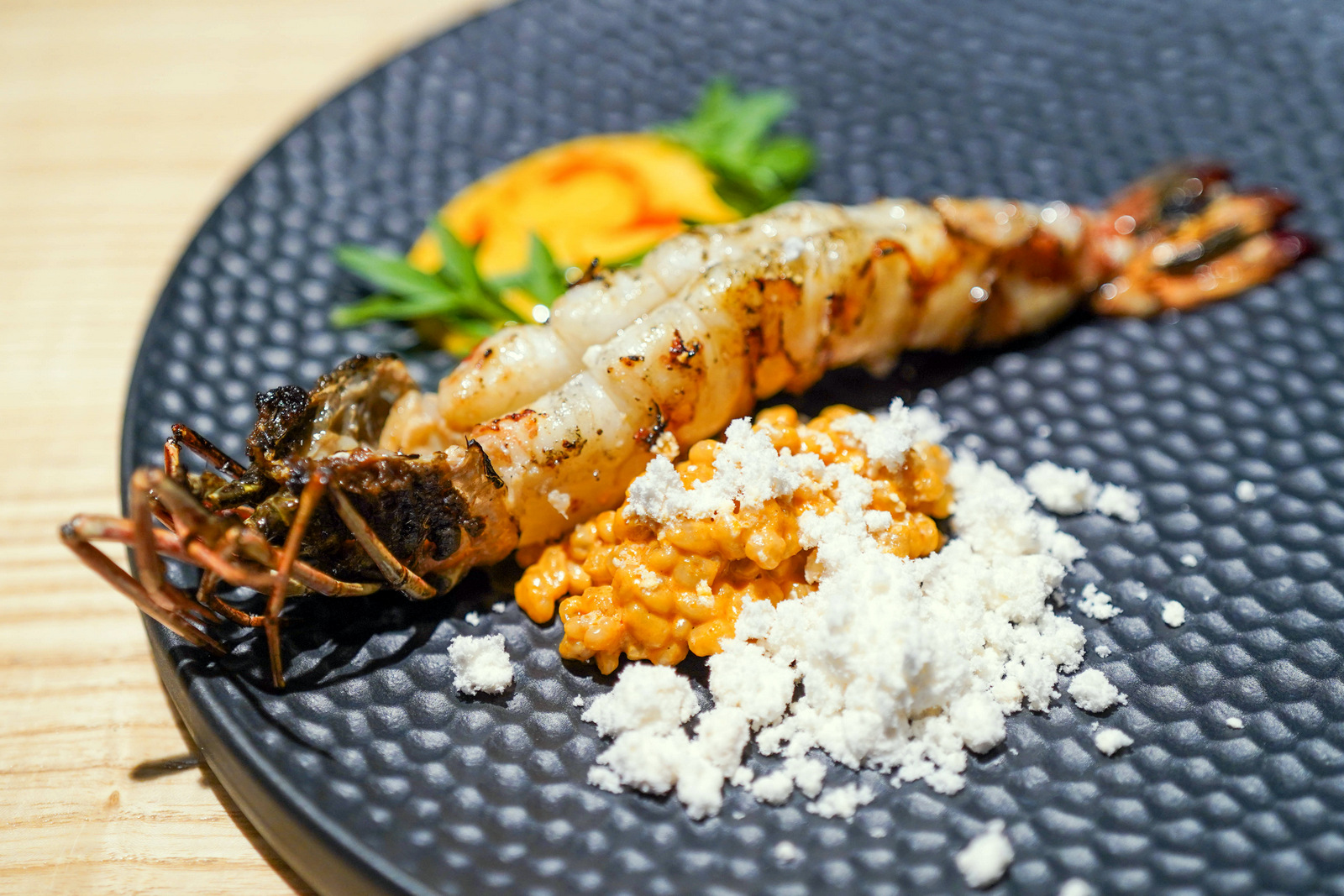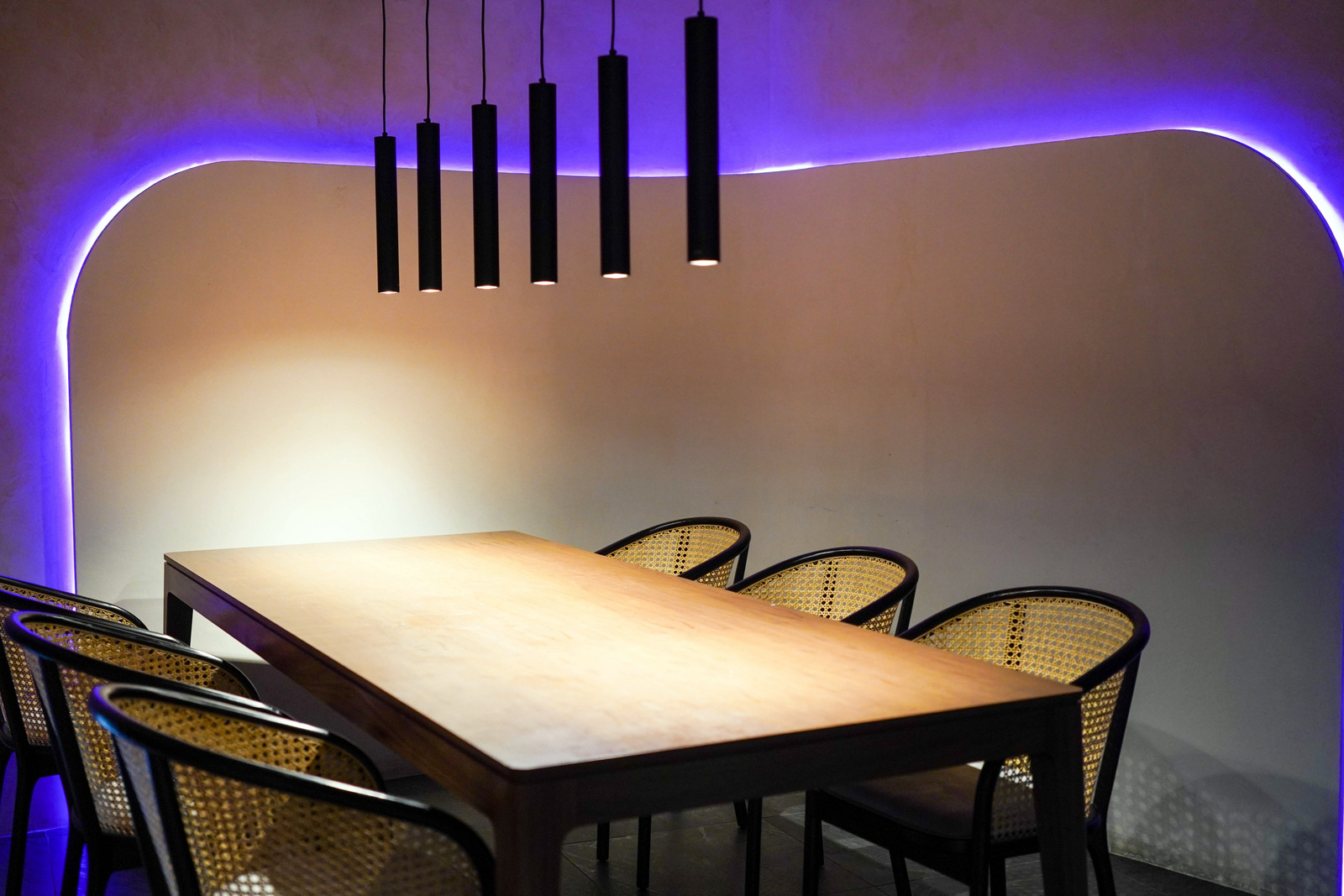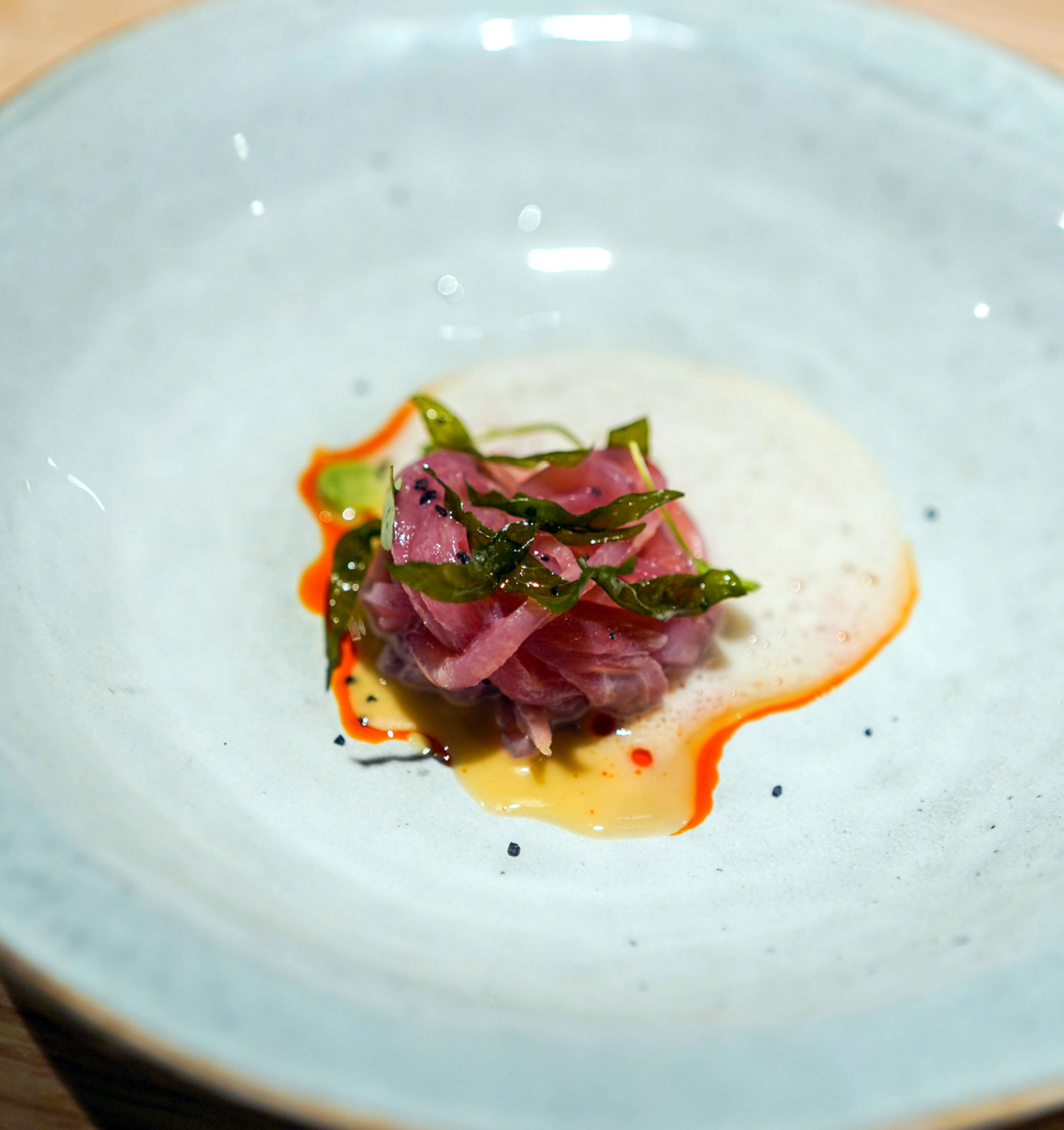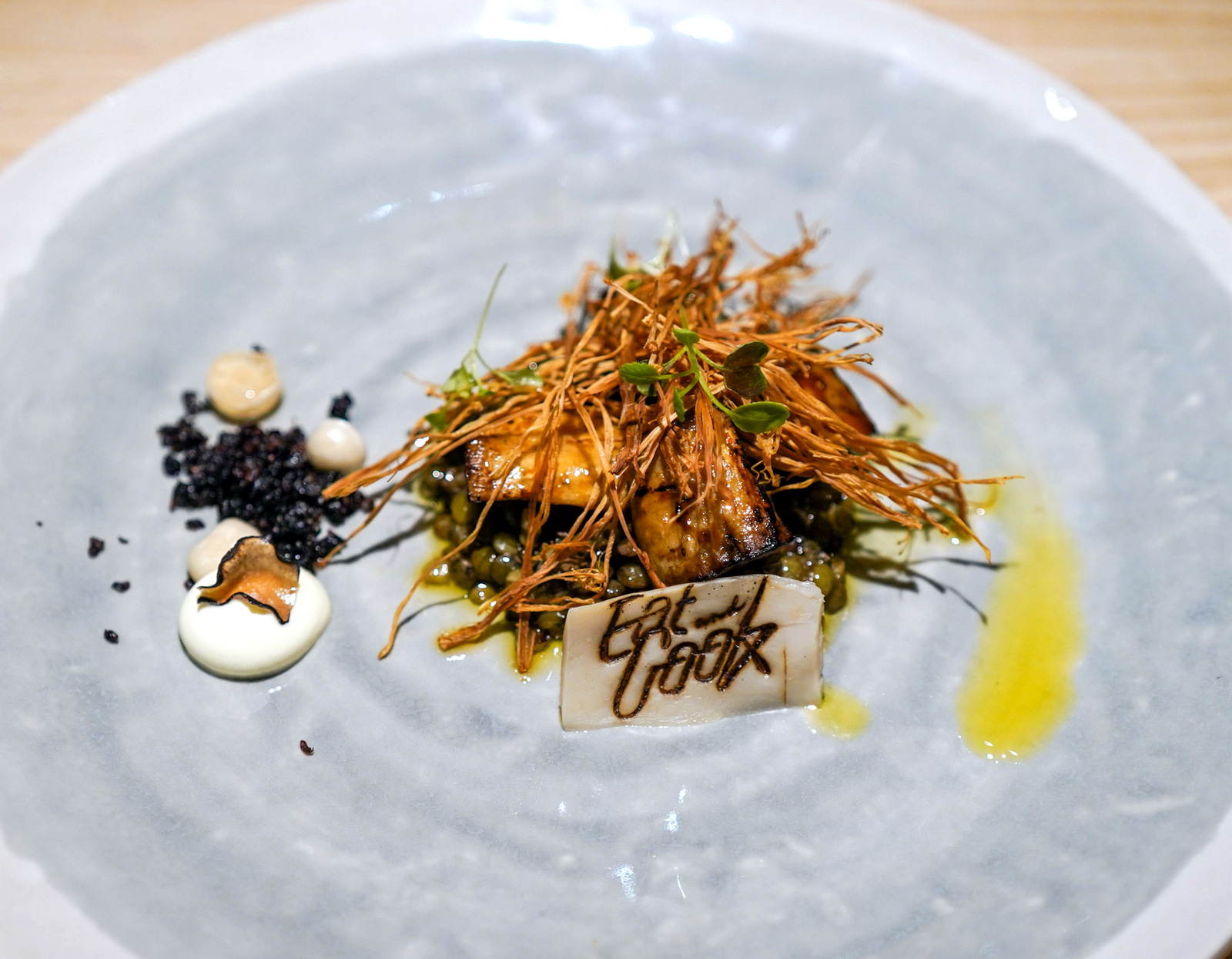As we walk through a passage into Eat and Cook, a neon sign overhead instructs, "Don't Doubt, Just Indulge." It might feel like the equivalent of Dante's 'Abandon all hope, ye who enter here,' especially since the restaurant's two head chefs are only 24 years old, steering a kitchen that seems impossibly ambitious.
But after three hours at Eat and Cook, it becomes clear that our skepticism was unfounded. Chefs Lee and Yong might be too young even for a quarter-life crisis, but they possess the prowess and poise, the imagination and intuition of many chefs twice their age.
These two fresh culinary stars take the stage in this intimate hotspot that's already booked out weeks in advance for dinner, bringing patrons on a journey that rekindles surprising memories of Malaysian flavours, some familiar and others somehow forgotten. If you like your meals to be an experience, an adventure into intriguing new territory, Eat and Cook is one ride to take.
Both Lee and Yong hail from towns in Perak, one from Teluk Intan, the other from Taiping. They first met five years ago while studying culinary arts in BERJAYA University College; their paths diverged after that, as they sharpened their skills at respected fine-dining restaurants in Kuala Lumpur.
Less than a year ago, they launched the initial iteration of Eat and Cook, testing the waters with a simple set-up hidden on the second level of a Bukit Jalil commercial development. Spurred by the encouraging response, the chefs teamed up with business partners Steve and Harry to open this new space in the same neighbourhood, sleekly centred around an open kitchen with about a dozen prime seats with a full view of all the action, alongside a small table nearby for several other diners.
Eat and Cook's degustation dinners reflect the spirit of Japanese-style omakase - if you're here on consecutive weekends, no two meals will ever be completely the same. What remains consistent are the crew's painstaking preparation (many of Eat and Cook's dishes feature five to six engaging elements, created from scratch) and promise of top-notch local produce (forget foie gras, truffles, lobster and wagyu beef - Eat and Cook delves deep into ingredients that hit compellingly closer to home).
Eat and Cook offers eight-course (RM380++) and five-course (RM260++) nightly menus, illustrated with icons and symbols of food - instead of text - to spark a sense of mystery. The entire menu changes each season, completely revamped every three months.
While the offerings continuously evolve, here's a glimpse into a mid-March meal that mightily impressed us. Eat and Cook graciously welcomed us here for lunch, for a calmer, comprehensive look at their work, which works wonders with zero wastage - even seafood shells and vegetable trimmings are turned into vital ingredients.
Kicking off with the eight-course selection, we break bread with bare fingers, courtesy of compressed towels to help out for hygiene. The crisp crust opens up with a fragrance not only of baking but lemongrass, ginger and galangal - Eat and Cook's tom yum ciabatta offers a tomato-tangy twist to dough and dip, with a Thai-inspired mix of herbs and chillies for an oil infused in bread and paste in butter.
Eat and Cook regularly switches up this starter with different, distinctive flavours - you might find turmeric-tinged, acar-inspired butter on one week, prawn bisque butter the next, and nam yu fermented beancurd butter after that. It's a punchy beginning to invigorate the palate, more thoughtful than the typical bread course.


Amuse-bouche rarely gets as nuanced as Eat and Cook's - one tartlet conveys carrots, the other channels sweet leaves, pure and free of seasonings.
The carrot is boiled with milk for six hours, blended without cream into a smooth puree that brings out the root vegetable's unmistakable natural sweetness, cushioned with a nest of julienne carrots, topped with cumin-cured, hay leaf-smoked carrot skin to ensure each component of the carrot receives its due.
The cekur manis is turned into a foam that vanishes in your mouth but lingers on your taste buds, crowned with crispy sweet leaves and beetroot strands, an ensemble that evokes the vegetable richness of lei cha.
Ceviche, unlike any we've ever had before. Wild-caught Indonesian tuna is sliced into thick 'noodles.' dressed with a foam that's flavoured with the stock of the fish's skin, bones and other leftover parts, plus subtly bitter kesom and zesty asam keping.
The result? A delicate-textured deconstruction of Penang's Assam Laksa, a showcase of briny-sweet oceanic succulence with a curing of condiments like calamansi with shrimp paste, yielding flavours that fully evoke Air Itam's robust bowls. A mouthwatering marvel.
Wild-caught seafood makes another brilliant appearance with the Borneo king prawns - ours were netted by fishermen in Semporna on a Monday, flown out of Sabah on Tuesday, and sourced from KL's Selayang market on a Wednesday.
Prawns like these need little cooking, grilled merely to medium, their flesh bridging the gap between translucent and opaque. Beside, barley risotto is showered with a dusting made of crustacean shells and trimmings rendered for hours, lending a lovely, light snowiness that still speaks of shrimp in flavour. A béarnaise sauce that borrows sweet-sour spiciness from sambal belacan ingredients rounds out the plate, finished with a green sprinkling of raja ulam.
Scallops are typically the stars of a dish, but here, it's the tomatoes and supporting players that steal the scene - no mean feat, since these Canadian scallops are perfectly pan-seared to medium doneness, with a clean, rich flavour that's free of seasonings.
What makes this memorable is the accentuating tang of ham choy that swirls around the scallops without overpowering them, a medley of salted vegetables and lacto-fermented Cameron Highlands tomatoes, tasting like a traditional home-cooked soup.
That's not all - there are also a sauce and crackers crafted from the scallop's skirt, shell and trimmings. It's a meticulous process: The shell, for example, is carefully cleaned, then cooked into a consommé, reduced to a stock, boiled with sago and dehydrated for three days, to be transformed into crackers that taste like the sea's saltiness.
As if that wasn't sufficient, there's a final flourish before serving, with the scallops sprayed with lemon and Sabah's lihing rice wine. It all adds up to one of the most delicious scallop dishes in KL, with everything on the plate harmoniously enhancing and elevating each other.
Cabbage is celebrated next, a combination of dry-aged and fermented purple, layered over pastry that's baked like fuchuk, piled with monk fruit, mandarins and torched longan for sweetish undercurrents, plated with a subtly earthy jus of cabbage trimmings, mushrooms and onions.
There's an enigma swaddled in this - a creamy-soft section that we believe might be yam. It turns out to be chicken liver pate, revelatory with garam masala and Cognac, a parcel of protein in what we thought was wholly vegetarian.
This palate cleanser is nicknamed a 'memory dish,' recalling after-school ice pop treats that primary students bought for 20 sen from the uncle on a motorbike outside their classroom gates. Coupled with calamansi and asam boi dust, it's a blast from the past with a twist, deja vu with a discernible difference.
Muscovy duck bred in Penang, far from its origins in Central America, come next.
The fowl is dry-aged for nearly three weeks, then air-dried for a day, hanging like a roast in a Cantonese kitchen, studded with coriander seeds and peppercorn.
It's then medium-grilled with Taiping-sourced mangrove charcoal, with its skin seared for a light crisp and its oil used to cook a side of turnip. Other accompaniments include a pomelo salad, chopped raw kantan, fish sauce, plus puff pastry filled with single-origin Semai chocolate from Pahang, a lovely pairing of meat and cocoa.
With duck this delectable, there's no need for a steak course. This is a smash that we'd order over a ribeye on an a la carte menu.
'Sashimi' of watermelon, compressed, charcoal-grilled, then sliced. Sorbet of Sarawak MD2 pineapple. A lush, luscious pairing of 'processed' fruits that trounces generic granita.
Dessert is derived from apam balik inspirations - again, it succeeds in replicating all that's spectacular about its source material, bringing together red corn puree with peanut butter, a baked honeycomb cake with burnt ends, and full-fat coconut ice cream.
Behind the scenes, a beachside's worth of coconuts goes into this every week. The coconut ice cream is like no other, made with a mix of young coconut meat (for silkiness and body), old coconut meat (for flavour and oil), coconut milk and flakes. What happens to the coconut water? Eat and Cook's kitchen brigade drinks that for hydration after all that effort.
Eat and Cook conceives its own chocolate truffles for the conclusion - one is deep and dark, broken down with fried cacao husks, with a tropical fruitiness that emerges where bitterness ends; the other is blended with torched fresh green and red peppercorns for a mala aroma, zinging our tongues gently at the end. On other occasions, you might find your chocolate laced with anything from ginger to lemongrass.
The five-course journey menu is more compact, just in case you have less stamina, time or cash.
As of mid-March, the tomatoes with scallops - a top three standout from the more comprehensive menu - was thankfully also part of the five-parter.
A mingling of mushrooms: Chargrilled king oyster mushrooms with a tender chew, dehydrated enoki mushrooms with a flaky bite, oven-cooked duxelle of shiitake for umami, shimeji with pickled piquancy, heaped over torched broccoli chips and buttery Le Puy lentils cooked in lentil stock, like a secret speciality that forest elves might make for themselves.
If you adore earthiness, all that feels like reason enough to book a seat at Eat and Cook ASAP. But of course, there's one more thing: Garlicky-nutty kulim fruit, a Malaysian truffle treasure, magicked into a slow-fire-cooked cream and a pungent perfume that's sprayed on serving.
Sea bream from off the shores of Penang surfaces next, grilled over sugarcane for a sweeter finish versus the ubiquitous charcoal - it's a smooth fish that's the best sort of ikan bakar, with a bevy of culinary companions, including seaweed for seasoning, and a six-hour-cooked, budu-infused seared tomato sauce, with budu cream and balsamic glaze, evidence of a delicate fish going divinely with tomato elements.
A whirl of liquid nitrogen obscures pickled onions and bunga kantan, a buoying and bracing balance of herbaceousness.
Agnolotti meets xiaolongbao: Instead of being stuffed with meat, the Piedmontese pure egg-yolk pasta is packed with the jus of dry-aged duck wings and feet, bursting in the mouth in a blaze of gelatinous glory, like a Shanghainese soup dumpling gone decadently Italian. Topped with dry-aged duck breast, scattered with shiitake duxelle, this breathes new life into freshly made pasta.
Apam balik and chocolate truffles make a welcome reappearance to close out the five courses.
All in all, the reincarnation of Eat and Cook is one of 2021's brightest entrants to KL's restaurant landscape.
Supporting independent farmers and swelling the horizons for what the country's young chefs are capable of, this is a kitchen with its heart, soul and spirit in the right place. Backed by Steve and Harry, chefs Lee and Yong own their stage and leave everything out there, stressing repeatedly that their mission is to take Malaysia's local ingredients to international levels of recognition.
Eat and Cook
H-6-1, Pusat Perdagangan Bandar, Jalan Persiaran Jalil 1, Bukit Jalil, 57000 Kuala Lumpur
Open Tuesday-Sunday, 6pm-11pm. Tel: 03-97656898
Reservations: eatandcook.asia/eat-and-cook-reservation
Instagram: instagram.com/eatandcook.asia
Facebook: facebook.com/Eatandcook.asia

